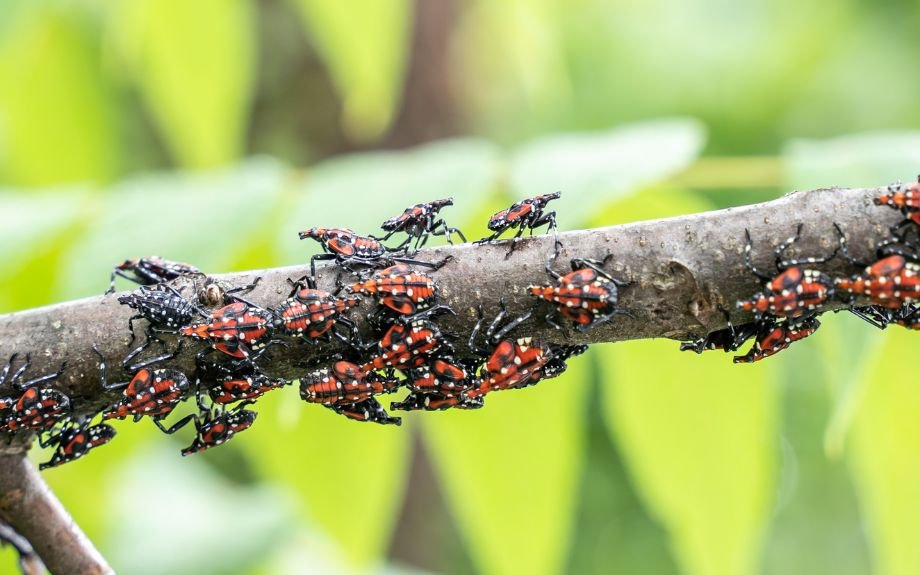The Spotted Lanternfly: A Potential Threat to Agriculture and The Environment
The spotted lanternfly, Lycorma Delicatula, is an invasive species that poses potential harms to agriculture and the environment. It is originally native to East Asian countries, including China, India, and Vietnam. It feeds on the sap of plants, weakening them and making them susceptible to diseases. It is considered a serious threat especially in areas outside its native range, where the pest has no natural predators. Since its introduction to the United States, which was first detected in Pennsylvania in 2014, the spotted lanternfly has rapidly expanded its range. Currently, it can be found in 17 states, including New Jersey, New York, Maryland, Virginia, and Ohio. This fall, I caught some of them myself in my backyard and got curious about them because they looked like butterflies and jumped high. I did some research and learned that they are nuisance pests, and as a Maryland resident, I am urged to report its sightings to the Maryland Department of Agriculture.
The insect utilizes its specialized mouthparts to pierce the plant's tissue, causing stunted growth and even death over time. Additionally, during the feeding process it excretes a sticky substance known as honeydew, attracting other pests and fostering the growth of sooty mold, which can further hinder photosynthesis and reduce crop yields. A high number of this insect as well as its expansion pose a significant threat, particularly to rural economies heavily reliant on agriculture and tourism as also reported on different news, weather and other channels. The Secretary of the Maryland Department of Agriculture, highlights “the negative impact that spotted lanternflies have on agricultural operations” declaring it “destructive” and “a dangerously injurious plant pest”. To aid the agriculture community and stop its spread he has issued quarantine orders for 19 Maryland counties and Baltimore City.
The spotted lanternfly appears to represent a significant menace to the agricultural industries in the region due to its voracious appetite for a wide variety of crops and plants. This invasive pest feeds on over 70 species, including economically important crops such as grapes, hops, apples, and peaches. Additionally, it targets hardwood trees like oak and pine, among many others. The feeding habits of the spotted lanternfly not only weaken the affected plants but also lead to a decline in crop yields, posing serious challenges for farmers and the overall agricultural economy in the area. Its ability to thrive on such a diverse range of vegetation makes it particularly difficult to control and manage, further exacerbating its impact on local agriculture.
The insect also poses significant economic threats, resulting in job losses. It has led to crop damage, export challenges, and increased management costs. Jayson Harper, a professor of agricultural economics and the director of Penn State’s Fruit Research and Extension Center, stated, “Even if the worst-case scenario does not materialize, the spotted lanternfly has already caused millions of dollars in damage to [his]state’s agriculture and forestry sectors. The vigorous response from the Pennsylvania Department of Agriculture, the U.S. Department of Agriculture, Penn State, and industry stakeholders to curb the spread of the spotted lanternfly is essential—our economy depends on it.”
A study conducted by economists at Penn State’s College of Agricultural Sciences concluded that the spotted lanternfly could potentially drain Pennsylvania’s economy by at least $324 million annually and result in the loss of approximately 2,800 jobs, particularly affecting those in the grape, apple, hops, and hardwood industries. On the other hand, many claim that the insect is not that harmful and may even benefit the environment. There are now many species of birds, animals, spiders that feed on Spotted Lanternfly helping to reduce their numbers so nature seems to find a way of balancing things out. Also, some scientists at Virginia Tech believe that the spotted lanternfly could play a role in spreading a fungus that would kill another invasive species, the tree of heaven. This tree, also originally from Asia, grows rapidly in natural areas and backyards, often overtaking habitats meant for native species, which include both plants and animals. The tree serves as a natural host for the lanternfly, and the fungus being developed by researchers could potentially eliminate both the tree and the fly. As a result of this project, some people believe it may be unreasonable to focus on exterminating the insects themselves and feel that there is no need to be overly concerned about them.
Nonetheless, the spotted lanternfly poses an ongoing threat to both the economy and the environment in the United States. Without proper restrictions in place, we risk losing plant life and jobs. Currently, the department has implemented quarantine measures to prevent the movement of regulated items that may contain the spotted lanternfly in any of its life stages, including egg masses, nymphs, and adults. It is important to know how they look in different stages of development and help prevent their spread by destroying the spotted lanternfly adults and nymphs when seen.
Regardless of whether this insect directly affects you, it remains essential to report any sightings of the spotted lanternfly through the Maryland Department of Agriculture’s online survey. Additional information can be found on the program's website.
References
Sottosanti, Karen. "spotted lanternfly". Encyclopedia Britannica, 24 Apr. 2024, https://www.britannica.com/topic/spotted-lanternfly. Accessed 10 November 2024.
Hacket, Jessica “Maryland Department of Agriculture Further Expands Spotted Lanternfly Quarantine Zone”. Maryland Department of Agriculture, 11 March. 2024. https://news.maryland.gov/mda/press-release/2024/03/11/maryland-department-of-agriculture-further-expands-spotted-lanternfly-quarantine-zone/. Accessed 10 November 2024.
Esterhuizen, Max. “Researchers receive USDA funding to combat devilishly invasive tree-of-heaven” Virginia Tech, 21 Oct 2024, https://news.vt.edu/articles/2024/10/cnre-research-tree-of-heaven.html. Accessed 10 November 2024
Duke, Amy, “Scientists examine potential economic impact of spotted lanternfly in Pa.”, PennState. 11 February 2020. https://www.psu.edu/news/research/story/scientists-examine-potential-economic-impact-spotted-lanternfly-pa. Accessed 10 November 2024. Accessed 10 November 2024.
“Spotted Lanternfly”, Animal and Plant Health Inspection Service, 24 September, 2024. https://www.aphis.usda.gov/plant-pests-diseases/slf, Accessed 10 November 2024.
